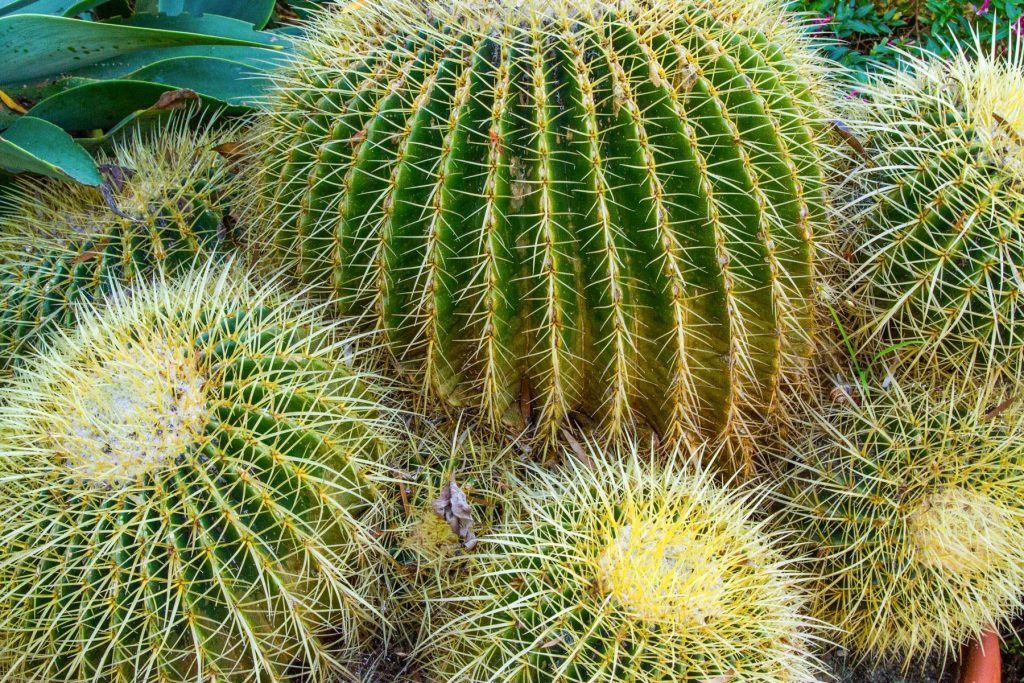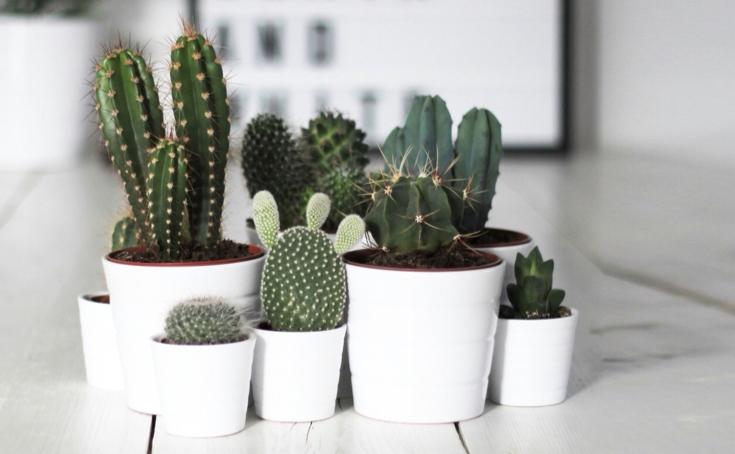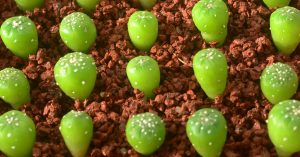The word cactus is derived from the Ancient Greek, Kaktos, a name first used by Theophrastus for a thorny plant. A Cactus belongs to the Plant Family Cactaceae, a family having 127 genera with some 1750 known species of the order Caryophyllales.

As Cacti grow in extremely dry environments, they show adaptations to save water. All the Cacti are succulents i.e. they have thickened flashy parts which store water. Mostly in all the Cacti, the stem is the only part which stores water unlike the other succulents. Cacti have spines, the modified leaves which prevent water loss and also protect the plants from herbivores. Stem is the only part of the cactus which carries out photosynthesis.
How to Take Cactus Cutting for Transplantation?
Cactus cutting if taken care can increase the chance of growing a new plant from the main cactus. How we take the cutting will depend on the type of cactus plant. The cactus having segmented stems are propagated from the segments. Barrel-shaped cacti plants produce new plants around the base of the main plant. The smaller plants can be removed to grow them into new cacti plants.
First, disinfect and clean a sharp knife or razor blade by washing them with soapy water or using alcohol. Pruning shears are not good for taking the cutting as they can crush the tissues of the cacti.
Disinfect every time you take the cutting by wiping the tools with alcohol or soapy water to avoid fungal infections and diseases.
Wear gloves to protect your hands from the spiny cacti and use tongs or a piece of cloth.
How to Propagate Christmas Cactus?
Christmas Cactus is very easy to propagate. Cut off a segmented pad from a healthy plant. Pads can be broken with tongs or a piece of cloth or a sharp knife. Smaller plants can be removed from the base of the cactus by cutting through the new plant base just beneath the soil surface. Keep them away from the direct sunlight and place the pads and barrel cuttings on a paper towel in such a way that their cut part is exposed to air. In two to four days the pads will become dry and callous.
Once dry dip the cut part of the pad in the rooting hormone( optional ). This step can be skipped if you want.
How to Transplant a Cactus Cutting?
Once the cut parts are dry and callous they are ready for transplantation. Take small pots of 4-6 inch diameter having drainage holes at the bottom so that the excess water is drained properly and the soil does not retain too much moisture.
Fill these pots with soil made by mixing the sand and peat. Put the barrel cuttings or the pads into the soil in such a way that the ½ inch of the cut end is buried in the soil. Sprinkle water so that the soil is moist. Be cautious while watering as excess water can rotten the transplanted cuttings.

You can also keep the pads flat. Instead of planting them directly you can choose to keep the pads flat till the roots start developing. Once the roots develop, plant them in pots. Water sparingly and wait for a few days before you water a newly potted pad. Moist the soil after a few days or only when the soil is dry. As the roots grow decrease the watering and let the soil dry before watering again.
Keep the pots in an area that receives indirect bright sunlight. Water the soil only when it is completely dry. Keep the soil barely moistened. Cactus cuttings develop roots generally in two to three weeks which is shown by the new growth on the cuttings.
How to Plant a Cactus Seed?
First step to planting cactus seeds is buying them from a garden supply store or you can buy them online. In the stores the seeds of different species are sold in small packets. The benefit of buying the seeds online is that you can select the species of your choice through a simple click and the delivery is done at your doorstep.
There is also an option of collecting the seeds from a blooming cactus.
Late winters or early spring is a good time to sow the seeds as the seedlings will get enough time to grow during the summers.

Cactus Seedlings are very sensitive and require protection from the direct sunlight. It is better to keep them indoors before slowly introducing them to the outer environment. The seed germination depends on the type of species and the atmosphere in which you are growing your cactus. If you grow your cactus indoors the seed germination is much faster as the environment is more controlled than the outdoors. Seed germination can occur between three to several months.
The seeds if grown outside can take many years to germinate. The seeds here will have to wait for the favorable conditions like ideal moisture and temperature unlike indoors where you have an option of putting a light shade window sill to enhance the germination process.
Cactus seedlings need proper care and protection from the sun for a few years. Place them in a shaded area or keep them indoors to fasten the seed germination.
Once they are an inch long you can put them in the sunlight. Slowly increase the time period of exposing them to the sunlight. The seedlings germinate slowly and it will take months to grow. When the cacti grow to the size of a marble it is thetime to shift these cacti into the pots.
How to get Cactus Pups to root?
Cactus offshoots are called pups which are produced by the parent plant. To root cactus pups, you need to cut them at a 45-degree angle and root them in well draining soil. Make sure your cut is slanting to not allow the water to stand as it may rot otherwise. Sometimes the gardeners dust the cut end of the pup with sulfur powder to prevent fungal infection and rot issues. Using sulfur dusting is optional if you allow the cut end to callous fully. The offshoot is ready for rooting when the cut end is dry and hard.

While taking the pups from the plant, the joint between the two should be clearly visible. If it is visible clearly, removing the offshoot is much easier. After taking the cutting ,make sure to remove any part of the parent plant from the pup otherwise the part will rot affecting the pup.
After taking the pup, the next step is to root it. This is an important step if the pup doesn’t have roots. Place your pups in the dry soil with gravel for a few days or one week. Watch them until they develop a few roots. Take them out as soon as they develop roots. You can also place them in small pots with sand, grounded charcoal, and perlite to grow roots. Skip this step for the pups having small roots.
Pups are the smaller parts of the plant which grow at the base. Remove the offshoots from the parent plant and root them in the potting mix and water properly. Cactus pups should be removed from the plant to decongest the crowded pots and enhance the growth of the original plant. Grow new plants from these pups. This is a vegetative form of plant propagation. It is the easiest method of developing a new plant. All the species of cactus cannot produce pups. Mostly barrel and rosette types of cacti produce pups. The big barrel cacti produce the biggest pups and are one of the best succulents to propagate.
Mostly the pups are formed at the base of the plant but some grow along the stem or also on the pads. Remove these offshoots from the plant and root them in a container to grow them into new plants. It is an easy process as long as you take clean cuts and let the offshoots be callous before rooting.
Once the pups develop roots, they are ready to be potted.
Do You Need to Water It Just After Rooting ?
Cactus can survive in extremely dry conditions. You can grow new cacti either from seeds or by taking the cuttings from a plant . Once the plants develop roots, you can water them if the soil is completely dry. Watering should be done in such a way that soil is moist. Too much moisture can rot the roots and will damage the plant.
How Long Does it Take a Cactus Cutting to Develop Roots ?
Time taken by the cuttings to develop roots depends upon a lot of factors like the species to which the cactus belongs, size of the cutting and watering regimen. Smaller cuttings will develop roots much faster than the larger cuttings. Normally the roots are formed in four to six weeks.
Always select healthy plants while taking the cuttings to enhance the chances of developing new plants from them.
